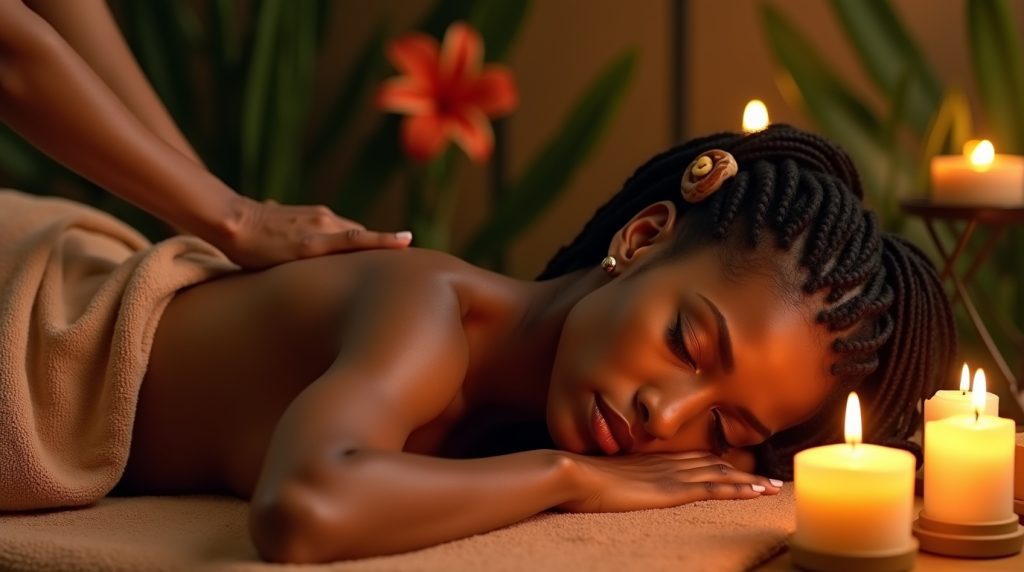A good back massage isn’t just a luxury—it’s a powerful way to relieve stress, ease muscle tension, and promote relaxation. Whether it’s after a long workday, post-workout soreness, or simply the need to unwind, a well-executed massage can do wonders for the body and mind. The back, in particular, carries a lot of tension due to poor posture, stress, and daily physical activities. Learning how to massage a back properly can help alleviate discomfort, improve circulation, and even boost overall well-being.
Many people assume that you need formal training to give an effective back massage, but the truth is, anyone can learn with the right techniques and a little practice. While professional massage therapy offers advanced techniques for deeper therapeutic benefits, a well-done at-home back massage can still provide significant relief. Whether you’re massaging a partner, a friend, or even practicing self-massage techniques, understanding the basics of pressure, motion, and muscle anatomy will make all the difference.
In this guide, we’ll take you through everything you need to know to give a relaxing and effective back massage. From preparing the perfect environment and choosing the right oils to learning step-by-step techniques, you’ll discover how to create an experience that soothes and rejuvenates. We’ll also cover common mistakes to avoid and pro tips to enhance the massage experience.
By the end of this guide, you’ll have the confidence to deliver a satisfying back massage that leaves your recipient feeling lighter, looser, and completely relaxed. So, grab your massage oil, find a comfortable space, and let’s get started on your journey to mastering the art of back massage!
1. Preparing for the Perfect Back Massage
A great back massage isn’t just about technique—it’s also about creating the right atmosphere. The right setting can make the difference between an average massage and an experience that leaves someone feeling truly relaxed and rejuvenated. Before you even start applying pressure, take the time to prepare your space, choose the right products, and set the right mood. Here’s how to do it:
Choosing the Right Space
The first step in preparing for a back massage is finding a suitable location. The space should be quiet, comfortable, and free from distractions. While professional massage therapists use tables specifically designed for body support, you can easily create a good setup at home. Here are a few options:
- Massage Table (Ideal Option): If you’re serious about giving massages regularly, investing in a portable massage table is a great idea. These tables provide proper support, have an adjustable height, and often come with face cradles for comfort.
- Bed: If a massage table isn’t available, a bed can work as long as the mattress is firm enough to provide stability. A very soft mattress can make it difficult to apply consistent pressure.
- Floor (with Cushions or a Yoga Mat): The floor can be a good option if you use a thick yoga mat or a few cushions to make it comfortable for the person receiving the massage.
No matter where you choose to give the massage, make sure the surface allows easy access to the back without forcing you to strain your posture.
Setting the Mood
A good back massage is not just about relieving muscle tension—it’s about creating an experience that promotes deep relaxation. Small details can make a big difference in how enjoyable the massage feels. Here’s how to set the perfect mood:
- Lighting: Soft, dim lighting is ideal for a relaxing massage. Avoid bright overhead lights and instead use lamps with warm-toned bulbs or candles for a calming glow.
- Music: Playing soft, instrumental music or nature sounds in the background can enhance the relaxation experience. Look for playlists designed for massage therapy or meditation.
- Temperature: Ensure the room is warm enough so the person receiving the massage doesn’t feel chilly, especially since they may be lying still for a while. If necessary, use a small heater or provide a blanket for extra comfort.
- Aromatherapy: Using essential oils or scented candles can help create a spa-like experience. Popular scents for relaxation include lavender, chamomile, sandalwood, and eucalyptus. However, always check for any sensitivities or allergies before using scented products.
Selecting the Right Oil or Lotion
Massage oil or lotion is essential for reducing friction and allowing your hands to glide smoothly over the skin. The right product can also nourish the skin and provide additional therapeutic benefits. Here are some of the best options:

- Coconut Oil: A popular choice due to its natural moisturizing properties and light texture. It absorbs well without feeling too greasy.
- Almond Oil: A great option for a smooth glide and rich in vitamin E, which is excellent for the skin.
- Jojoba Oil: Hypoallergenic and closely resembles the skin’s natural oils, making it ideal for sensitive skin.
- Professional Massage Oils: If you prefer a non-greasy option, many brands offer professional-grade massage oils with blends designed for relaxation or deep tissue work.
- Lotion or Cream: For those who prefer a non-oily option, massage lotions or creams can provide enough slip while being more absorbent.
Before applying any oil or lotion, warm it up by rubbing a small amount between your hands. Cold oil can be a shock to the skin and disrupt the relaxation process.
Getting the Person Comfortable
Once your space is ready and you have your oil, it’s time to ensure the person receiving the massage is as comfortable as possible.
- Positioning: Have the person lie face down with their arms resting at their sides or folded under their head for support.
- Using a Pillow or Rolled Towel: Placing a small pillow or rolled towel under the ankles can help take pressure off the lower back, making the position more comfortable.
- Communication: Before starting, ask about any areas of discomfort or tension and check if they have any injuries or sensitivities. This helps tailor the massage to their needs.
Final Preparations
Before you begin the massage, take a moment to center yourself. Massaging requires not only physical effort but also a calm and focused mindset. Take a few deep breaths, relax your own muscles, and get into a steady rhythm. Keep a towel nearby in case you need to wipe excess oil from your hands, and make sure you’re in a comfortable stance to prevent fatigue.
Now that everything is set, it’s time to start the massage! In the next section, we’ll dive into the basic back anatomy and how to apply the right pressure to ensure a soothing and effective massage.
2. Understanding Basic Back Anatomy
Before diving into massage techniques, it’s important to understand the basic structure of the back. While you don’t need to be a trained physiotherapist, having a general idea of where major muscles are located will help you apply pressure in the right places and avoid sensitive areas like the spine. A good massage isn’t about pressing randomly—it’s about targeting muscle groups effectively to relieve tension and promote relaxation.
Key Muscle Groups in the Back
The back is made up of multiple layers of muscles that support the spine, allow movement, and store tension. Here are the primary muscle groups to focus on during a massage:
- Trapezius (Traps)
- Located at the upper back, covering the shoulders and extending down the middle of the back.
- Common area for tension due to poor posture, stress, or prolonged sitting.
- Massaging this area can help relieve neck stiffness and upper back pain.
- Latissimus Dorsi (Lats)
- Large, broad muscles running from the lower back to the sides of the torso.
- These muscles are heavily used during lifting and pulling motions.
- Massaging the lats can improve flexibility and reduce lower back stiffness.
- Erector Spinae
- A group of muscles that run along both sides of the spine from the lower back up to the neck.
- Helps support posture and spinal movement.
- Deep tissue techniques can help relieve chronic back pain and tightness.
- Rhomboids
- Located between the shoulder blades.
- These muscles are crucial for posture and are often tight in people who hunch forward.
- Targeting this area can help reduce shoulder tension and improve upper back mobility.
- Gluteus Muscles (Glutes)
- Though technically part of the lower body, the glutes play a crucial role in back support.
- Tight glutes can contribute to lower back pain.
- Massaging the lower back and gluteal muscles can enhance overall relaxation.

Understanding Pressure Points and Sensitivity
When massaging the back, it’s crucial to apply pressure strategically. Here are a few things to keep in mind:
- Avoid Direct Pressure on the Spine: The spine is made up of vertebrae and is sensitive to direct pressure. Focus on the muscles on either side instead.
- Identify Tension Spots (Knots): Muscle knots, or trigger points, are small, tight areas in the muscle that can cause discomfort. Applying gentle, targeted pressure can help release them.
- Adjust Pressure Based on Comfort: Some areas may be more sensitive than others. Always check in with the person receiving the massage to ensure the pressure feels good.
Why Muscle Knowledge Matters
Understanding where the muscles are located and how they function allows you to:
- Target the right areas for maximum relief.
- Avoid applying pressure in ways that could cause discomfort or injury.
- Adapt your massage technique to suit the person’s needs, whether they need gentle relaxation or deeper tension relief.
Now that you have a basic understanding of back anatomy, it’s time to put that knowledge to work! In the next section, we’ll go through step-by-step massage techniques that will help you deliver a truly soothing and effective back massage.
3. Step-by-Step Back Massage Techniques
Now that you understand back anatomy, it’s time to apply that knowledge with hands-on techniques. A great back massage isn’t just about pressing or rubbing randomly—it follows a structured flow that warms up the muscles, works through tension, and finishes with a soothing touch. Below is a step-by-step guide to ensure your massage is both effective and relaxing.
Step 1: Effleurage (Warm-up Strokes)
Effleurage is a gentle, gliding stroke used at the beginning of the massage to spread the oil, warm up the muscles, and ease the person into relaxation.
How to Perform Effleurage:
- Apply a small amount of warm massage oil to your hands and rub them together.
- Start at the lower back and use both hands to glide upward toward the shoulders.
- Use long, sweeping strokes with moderate pressure, keeping your hands flat.
- Once you reach the shoulders, gently circle outwards and glide back down to the lower back.
- Repeat for about 2-3 minutes to help relax the muscles and prepare for deeper work.
Step 2: Petrissage (Kneading for Tension Relief)
Petrissage involves kneading, lifting, and rolling the muscles to relieve tension and improve circulation. This technique helps break up knots and increase blood flow to tight areas.
How to Perform Petrissage:
- Use your palms, thumbs, and fingers to gently lift and squeeze the muscles.
- Work in a rhythmic motion, applying more pressure to tight areas.
- Focus on the upper back, shoulders, and lower back, where tension is most common.
- Avoid pinching or applying excessive pressure, especially near the spine.
- Perform this technique for about 3-5 minutes.
Step 3: Friction (Deep Circular Movements to Release Knots)
Friction techniques use deeper pressure to target specific tight spots (muscle knots). This helps release chronic tension and improve mobility.
How to Perform Friction:
- Use your thumbs or knuckles to apply circular pressure to tight areas.
- Move slowly, pressing deeply but not to the point of pain.
- Focus on the rhomboids (between the shoulder blades) and lower back, common areas for knots.
- If you find a particularly tight spot, hold pressure there for a few seconds until the muscle starts to relax.
- Continue for 2-3 minutes, adjusting pressure as needed.
Step 4: Tapotement (Rhythmic Tapping for Stimulation)
Tapotement is a percussive technique that involves rhythmic tapping to stimulate circulation and energize the muscles. It’s great for finishing the deeper massage work with an invigorating touch.
How to Perform Tapotement:
- Use the sides of your hands to lightly chop along the back (like a karate chop but relaxed).
- Cup your hands and gently tap the back, creating a soft drumming effect.
- Keep your wrists loose to prevent discomfort for both you and the recipient.
- Use a rapid but controlled motion for about 1-2 minutes.
Note: Tapotement is best used toward the end of a massage or on areas that need stimulation. Avoid using this technique on the lower back if the person has sensitivity in that area.
Step 5: Stretching and Finishing Touches
After working through the muscles, it’s time to bring the massage to a relaxing close with gentle stretching and light strokes.
How to Perform the Final Steps:
- Use slow, light strokes similar to effleurage to bring the person back to a state of relaxation.
- Gently stretch the shoulders by moving them slightly back and forth.
- If comfortable, apply a small amount of pressure to the lower back while gently stretching.
- Finish with feather-light touches using just your fingertips to soothe the skin.
How Long Should a Back Massage Last?
- Quick Relaxation Massage: 10-15 minutes (focuses mainly on effleurage and light kneading).
- Standard Full Back Massage: 20-30 minutes (incorporates deeper techniques like petrissage and friction).
- Intensive Deep Tissue Massage: 40+ minutes (focuses on breaking down knots and improving muscle function).
Adjusting Pressure for Maximum Comfort
- For a Relaxing Massage: Use slow, fluid motions with light to moderate pressure.
- For Tension Relief: Apply deeper kneading and friction techniques but avoid excessive force.
- For a More Intense Massage: Gradually increase pressure over time rather than starting too strong.
Always communicate with the person receiving the massage. Ask them how the pressure feels and adjust accordingly. The goal is relaxation, not discomfort.
With these techniques in place, you’re well on your way to delivering a soothing and effective back massage! Up next, we’ll cover some common mistakes to avoid so you can ensure a smooth and enjoyable experience.
4. Common Mistakes to Avoid
Even with the best intentions, certain mistakes can make a back massage less effective or even uncomfortable. Whether you’re a beginner or improving your technique, avoiding these common errors will help ensure a smooth, relaxing, and beneficial massage.
1. Applying Too Much Pressure on the Spine
The spine is one of the most sensitive areas of the body, made up of vertebrae, nerves, and discs that aren’t meant to be directly compressed.
Why It’s a Mistake:
- Direct pressure on the spine can cause discomfort and even pain.
- Spinal nerves are delicate, and pressing too hard can lead to irritation or soreness.
- The goal is to massage the muscles surrounding the spine, not the spine itself.
How to Avoid It:
- Always apply pressure to the muscles on either side of the spine, not directly on the bones.
- Use light strokes when gliding over the spine, focusing deeper pressure on the back muscles.
2. Not Warming Up the Muscles First
Jumping straight into deep pressure without preparing the muscles can make the massage painful rather than soothing.
Why It’s a Mistake:
- Cold, tense muscles are less flexible and more resistant to deep pressure.
- A sudden deep massage can cause discomfort or even muscle strain.
How to Avoid It:
- Always start with effleurage (long, flowing strokes) to warm up the muscles.
- Gradually increase pressure as the muscles begin to loosen.
3. Neglecting Communication
Many people assume they should stay silent during a massage, but this can lead to discomfort if the pressure is too much (or too little).
Why It’s a Mistake:
- Each person has a different pain threshold and preference for pressure.
- Without communication, you might be pressing too hard or too lightly.
How to Avoid It:
- Ask the person receiving the back massage how the pressure feels.
- Encourage them to speak up if anything feels uncomfortable.
- Adjust your technique based on their feedback.
4. Rushing the Massage
A back massage should be a slow, intentional process. Moving too quickly can make it feel less effective and less relaxing.
Why It’s a Mistake:
- Fast, erratic movements can feel chaotic rather than calming.
- Rushing through the massage doesn’t give muscles time to fully relax.
How to Avoid It:
- Use slow, steady movements with consistent pressure.
- Maintain a rhythmic flow rather than hurrying through the techniques.
- Take your time with each stroke to maximize relaxation.
5. Overusing Your Thumbs
Beginners often rely too much on their thumbs for deep pressure, which can lead to hand fatigue and discomfort.
Why It’s a Mistake:
- Thumbs can become sore and tired quickly.
- Overuse can lead to strain or even injury over time.
How to Avoid It:
- Use the palms, knuckles, or forearms for deeper pressure instead of just your thumbs.
- When using thumbs, keep them supported by other fingers to reduce strain.
- Take breaks and stretch your hands if they start to feel fatigued.
6. Ignoring the Lower Back and Shoulders
Many people focus on the mid-back but forget that tension also builds in the lower back and shoulders.
Why It’s a Mistake:
- The lower back supports the entire upper body and can accumulate a lot of strain.
- The shoulders carry stress from posture, work, and daily activities.
How to Avoid It:
- Spend extra time working on the shoulder blades and lower back where tension is common.
- Use gentle circular motions around the lower back rather than deep pressure.
7. Not Paying Attention to Posture (for the Masseuse)
Giving a massage can be physically demanding. If you don’t position yourself correctly, you’ll tire quickly and may even hurt yourself.
Why It’s a Mistake:
- Poor posture can cause back and wrist strain.
- Leaning over awkwardly reduces control over your movements.
How to Avoid It:
- Keep your back straight and your shoulders relaxed while massaging.
- Bend your knees slightly and shift your weight rather than using just your arms.
- Use a massage table or a firm surface at a comfortable height to avoid hunching over.
8. Using Too Much or Too Little Massage Oil
The right amount of oil ensures smooth movements, but too much can make the skin feel greasy, while too little can cause friction.
Why It’s a Mistake:
- Too much oil makes it difficult to apply pressure.
- Too little oil causes unnecessary drag and discomfort.
How to Avoid It:
- Start with a small amount of oil and add more as needed.
- Warm the oil in your hands before applying for a more comfortable experience.
9. Forgetting to End the Back Massage Properly
A sudden stop can leave the person feeling unsatisfied or even startled.
Why It’s a Mistake:
- A massage should gradually transition from deep techniques to lighter strokes before ending.
- Ending abruptly can cause the muscles to tense up again.
How to Avoid It:
- Finish with slow, light strokes (effleurage) to bring the session to a gentle close.
- Let the person rest for a moment before getting up.
Final Thoughts
By avoiding these common mistakes, you can ensure that your back massage is as enjoyable and effective as possible. The key is to be mindful, patient, and communicative. A well-performed massage should leave the recipient feeling relaxed, refreshed, and free of tension—not sore or uncomfortable.
Up next, we’ll cover pro tips to take your massage skills to the next level and create an even better experience.
5. Tips for an Even Better Back Massage Experience

A good back massage can relieve stress and tension, but a great back massage feels like pure bliss. By incorporating a few extra touches and refinements, you can take your back massage from basic to exceptional. Whether you’re looking to enhance relaxation, improve technique, or create a more immersive experience, these tips will help elevate your massage skills.
1. Adjust the Pressure Based on the Recipient’s Comfort
Not everyone enjoys the same level of pressure, and some areas of the back may be more sensitive than others.
How to Do It Right:
- Start with light pressure and gradually increase it based on feedback.
- Pay attention to body language—if the person tenses up, the pressure might be too much.
- Use deeper pressure on tense muscles but avoid excessive force, especially in bony areas.
💡 Pro Tip: If you’re unsure whether the pressure is right, ask: “Does this feel good, or would you like more or less pressure?”
2. Use Breathing Techniques to Enhance Relaxation
Encouraging deep breathing can help the person receiving the back massage relax even more.
How to Do It Right:
- Before starting, ask the recipient to take a few slow, deep breaths.
- Sync your strokes with their breath cycle—apply pressure as they exhale for deeper relaxation.
- Remind them to breathe naturally, especially when working on tense areas.
💡 Pro Tip: If the person is holding their breath or breathing shallowly, remind them to exhale deeply with each stroke.
3. Incorporate Warm Towels or Heating Pads
Heat helps loosen up tight muscles and enhances relaxation before and after the massage.
How to Do It Right:
- Place a warm towel on the back before starting to help relax the muscles.
- Use a heating pad for a few minutes before working on areas with deep tension.
- After the massage, a warm towel on the back can help seal in the soothing effect.
💡 Pro Tip: Avoid using excessive heat on sensitive skin and always test the temperature before applying.
4. Use the Right Hand Techniques for Less Strain
Massaging for long periods can be tiring, but using the right techniques can reduce hand fatigue.
How to Do It Right:
- Instead of relying only on your thumbs, use your palms, forearms, and knuckles for deeper pressure.
- Keep your wrists relaxed and use your body weight rather than just your arm strength.
- Adjust your posture to keep your movements fluid and comfortable.
💡 Pro Tip: If your hands start feeling tired, switch to using your forearms for broad, sweeping strokes.
5. Add Aromatherapy for a Spa-Like Experience
Scent plays a huge role in relaxation, and incorporating aromatherapy can enhance the mood of the massage.
How to Do It Right:
- Use essential oils like lavender, chamomile, or eucalyptus in a diffuser.
- Choose massage oils with natural scents for an added aromatherapy effect.
- Be mindful of allergies—always check if the person is sensitive to certain scents.
💡 Pro Tip: If you’re massaging someone before bedtime, lavender oil can help promote deeper sleep.
6. Pay Attention to Temperature and Comfort
Nothing ruins a massage faster than feeling too cold or uncomfortable.
How to Do It Right:
- Keep the room warm enough so the person doesn’t feel chilly.
- Use a blanket to cover areas of the body that aren’t being massaged.
- Ensure the massage surface is firm yet comfortable to prevent discomfort.
💡 Pro Tip: A warm, cozy environment helps the person relax more deeply and enjoy the massage longer.
7. Maintain a Consistent, Flowing Rhythm
A massage should feel smooth and natural—not choppy or disjointed.
How to Do It Right:
- Avoid stopping and starting too frequently.
- Maintain a steady pace and rhythm to keep the experience seamless.
- If moving from one area to another, transition smoothly rather than abruptly changing techniques.
💡 Pro Tip: Think of a massage as a dance—your hands should move rhythmically and fluidly over the back.
8. Focus on Problem Areas Without Overworking Them
It’s important to address knots and tension spots, but excessive pressure can make muscles feel sore instead of relieved.
How to Do It Right:
- Apply gradual pressure on knots instead of pressing too hard right away.
- If a muscle is particularly tight, hold steady pressure for 10-15 seconds and then release.
- Alternate between deep strokes and gentle kneading to avoid overstimulating tense areas.
💡 Pro Tip: If a muscle remains tight despite multiple passes, move on and return to it later rather than overworking it.
9. Encourage Hydration After the Massage
Drinking water after a massage helps flush out toxins released from tight muscles.
How to Do It Right:
- Offer the recipient a glass of water after the session.
- Encourage them to drink fluids to stay hydrated and prevent soreness.
- Herbal teas (like chamomile or peppermint) can also complement the relaxation process.
💡 Pro Tip: Dehydrated muscles are more prone to soreness—hydration helps maximize the benefits of the massage.
10. Know When to Recommend a Professional Massage
While a home massage is great for relaxation, some conditions require professional attention.
When to Suggest a Pro Massage:
- If the person has chronic pain or a history of back injuries.
- If they need sports recovery therapy or deep tissue work beyond basic techniques.
- If they experience severe discomfort that home massages can’t relieve.
💡 Pro Tip: If the person complains of sharp pain, numbness, or nerve issues, it’s best to recommend a licensed massage therapist or a physiotherapist.
Final Touches for an Unforgettable Experience
By incorporating these pro tips, your massage will feel more luxurious, effective, and enjoyable. Whether you’re massaging a partner, friend, or family member, small details make a big difference.
✔️ Adjust pressure to comfort levels.
✔️ Use aromatherapy and warm towels for a spa-like experience.
✔️ Keep movements fluid and consistent.
✔️ Encourage hydration and post-massage relaxation.
With practice, your massages will feel not just good—but amazing.
Bringing It All Together
Mastering the art of back massage isn’t just about applying pressure—it’s about creating an experience that promotes relaxation, relieves tension, and leaves the recipient feeling renewed. With the right preparation, techniques, and attention to detail, you can transform a simple back rub into a deeply therapeutic and enjoyable massage.
We’ve covered everything from setting the perfect environment and understanding back anatomy to step-by-step techniques and pro tips to elevate your skills. Whether you’re giving a back massage to a loved one or simply improving your technique, remember these key takeaways:
✅ Set the Mood: A quiet space, dim lighting, soothing music, and the right oil create the ultimate relaxation experience.
✅ Use Proper Techniques: Start with gentle effleurage, move into deeper kneading and friction, and finish with light strokes.
✅ Adjust to Comfort Levels: Everyone has different sensitivity—communicate and adapt pressure accordingly.
✅ Avoid Common Mistakes: Don’t press on the spine, don’t rush the process, and don’t overwork tense areas.
✅ Enhance the Experience: Warm towels, aromatherapy, and breathing techniques can make a big difference.
✅ Know When to Refer to a Pro: If there’s chronic pain or serious muscle issues, a professional massage therapist is the best choice.
With practice, your confidence in giving massages will grow, and your ability to relieve stress and muscle tension will improve. Whether it’s a quick 10-minute relaxation session or a full 30-minute deep tissue massage, the techniques you’ve learned here will help you provide comfort and relief in a way that feels natural and intuitive.
So, go ahead—grab some massage oil, find a willing recipient, and start perfecting your skills. The more you practice, the better you’ll get, and soon enough, you’ll be giving professional-quality massages right at home!







